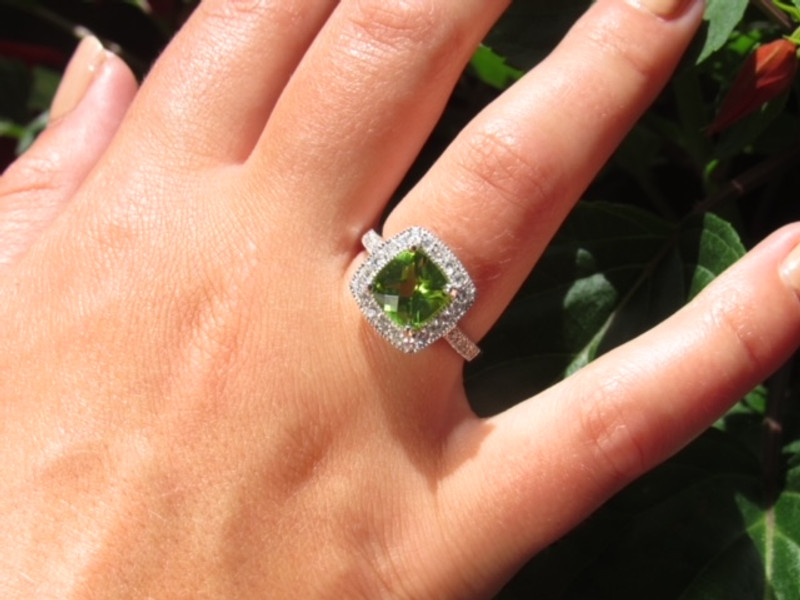Those of us born in August are lucky to have a choice of two fabulous birthstones, peridot and spinel. Since August is my birth month, I am particularly fond of these two less well known, but beautiful gemstones. This blog covers peridot, while spinel is the topic of its own, separate blog; August Birthstone: Spinel - facts and lore
Peridot has always been associated with light. In fact, early Egyptians called it “gem of the sun.” The gem variety of the mineral olivine, peridot, has also earned a special designation as the extreme gem becauseof the severe conditions under which it forms:
- Scientists determined that some olivine and peridot have extraterrestrial beginnings. It’s been identified in meteorites and has been linked to the creation of our solar system and new stars in the galaxy.
- When formed on earth, peridot and diamond are brought to us under much more extreme conditions than other gemstones. They form much deeper beneath the earth’s surface in the mantle and at higher temperatures. Diamond and peridot are also similarly brought to earth’s surface by tectonic or volcanic activity.
Peridot’s extraterrestrial origin story developed as scientists studied thousands of meteorites which hit the earth since its creation. Some of those meteorites, known as pallasites, are composed of nickel-iron and olivine/peridot. Pallasite meteorites are believed to have been part of a planet that orbited between Mars and Jupiter during the early stages of our solar system. Another possibility is some pallasite meteorites might have been pieces of a large 4.5 billion year old asteroid.
In 2004, NASA launched the Stardust spacecraft to collect comet and interstellar dust from outside the orbit of the moon. In 2006, the extraterrestrial relationship was strengthened when olivine/peridot was found in the space dust collected and sent back by Stardust. In 2011, a historic first occurred when NASA's Spitzer Space Telescope captured images of new stars being created. Scientists witnessed tiny crystals of peridot falling like rain through the dusty cloud of gas of a developing star.
Peridot’s extraterrestrial connection inspired me when designing a three piece suite of peridot earrings, necklace and bracelet. Two of the three are seen below. Look at those images and think of Saturn with its system of rings, or far-off solar systems comprised of a sun and orbiting planets.
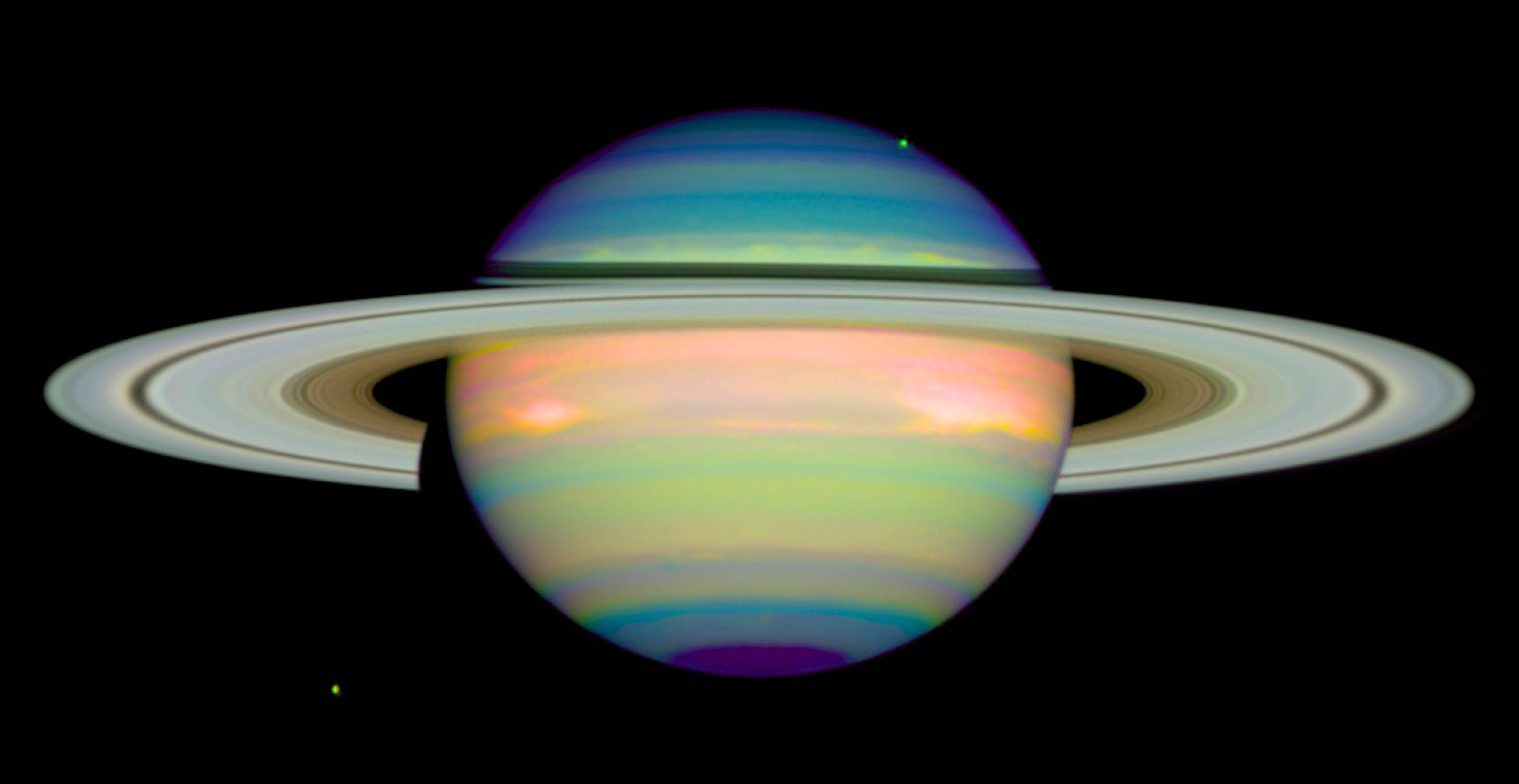
The peridot gemstones represent the planet with the gold encircling the peridots representing the ring system.
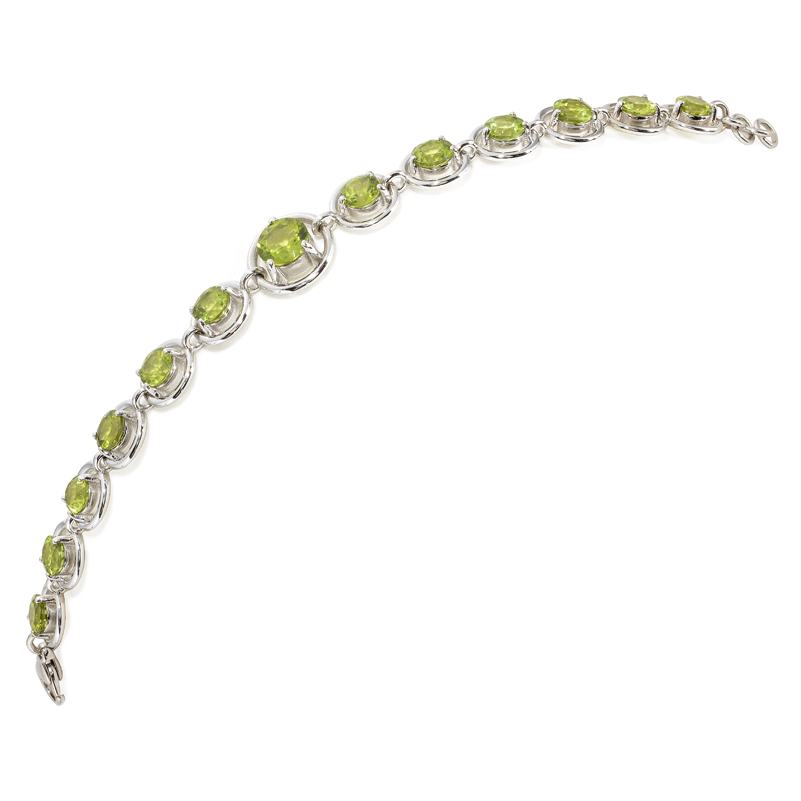
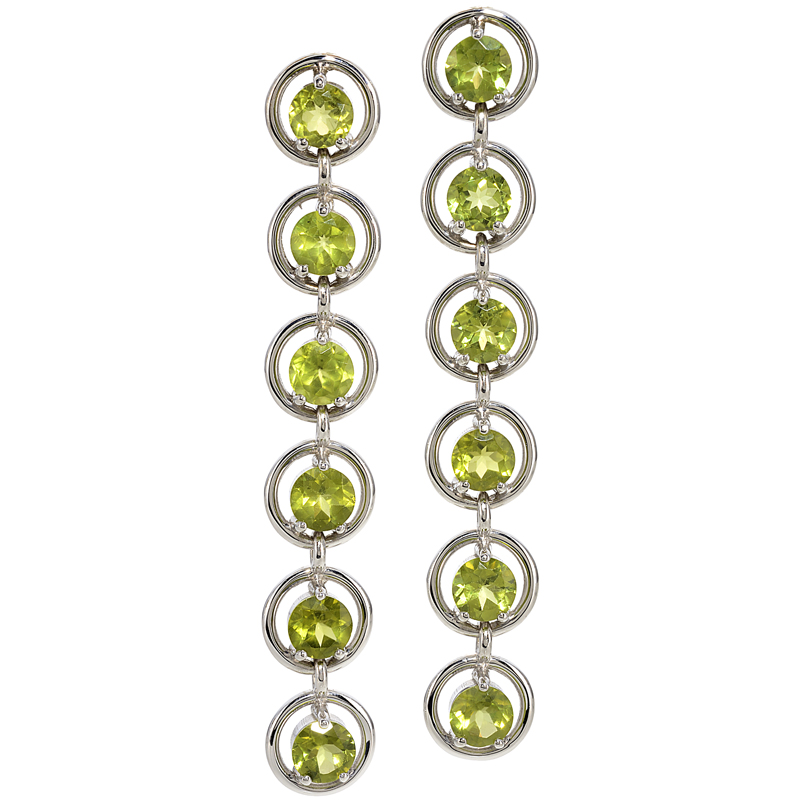
Click the link to browse the current 100 East Fine Jewelry Peridot Collection.
During earth’s prehistoric beginnings, mountains and islands were formed through violent volcanic eruptions, some of which brought peridot crystals to the earth’s surface. Fast forward to today and imagine walking barefoot on sparkling green sand that owes its unique color to olivine and peridot crystals eroded from those ancient volcanic formations. Four known green sand beaches exist on earth; Mahana Beach on Hawaii’s big island, Talafofo Beach on Guam, Norway’s Lake Hornindalsvatnet and The Green Beach on Floreana Island in The Galápagos.
Mahana Beach’s sand, on the undeveloped southern tip of Hawaii’s big island, is rich in peridot and olivine, common mineral components of Hawaiian lava. Locals refer to peridot as the “Hawaiian Diamond,” with small peridot stones sold as “Pele’s tears” in honor of the goddess of fire and volcanoes. In ancient Hawaiian chants, Pele was described as “She who shapes the sacred land,” and her temper was known to be both abundant and dangerous. The island of Oahu also has beaches bearing small amounts of tiny peridot crystals mixed with its sand that are too small to be faceted as gemstones.
Besides an August birthstone, peridot is also recognized as the preferred gemstone for the 16th wedding anniversary.
History and Lore
The word peridot comes from the Arabic word “faridat,” which translates to “gem”. For many years, though, peridot was confused with other gems. The Red Sea island of Topazios, believed to be the source of the gem name “topaz,” actually produced peridot. As a result, for a time, peridot was frequently called “topaz.” During medieval times peridot was often confused with emerald. For centuries, people believed the five enormous 200 ct gems adorning the top of the Shrine of the Three Holy Kings in Germany’s Cologne Cathedral were emeralds. They are actually peridot. Some historians even speculate Cleopatra’s famous emerald collection may have been comprised of peridot.
Despite the name confusion, peridot has been treasured for over 4,000 years for its restful hues. The earliest surviving written records indicate ancient Egyptians may have begun organized peridot mining on a tiny volcanic island in the Red Sea then called Topazios, which is now known as Zabargad or St John’s Island, around the 4th century BC. Zabargad only covers an area of about 4.5 square km (approximately 1.7 square miles). Hardly any life existed on the island; and no fresh water. It could justly be described as a "desert island." Although the island produced beautiful peridot, its harsh conditions and legends of being infested with snakes earned it ominous names like Island of Death and Ophiodes (“Snake Island”). Ancient Egyptians so treasured Peridot that the location of its fog-shrouded mines were a closely guarded secret.
Zebargad is the source of many large, fine peridots, which can be found today in museums around the world. With the fall of the Egyptian empire, the island became lost to antiquity, and was only rediscovered in 1906. The deposits were nationalized by Egyptian President G. A. Nasser in 1958, and since then the peridot deposit has been worked only sporadically.
Peridot was highly valued by many ancient and medieval cultures. It appeared in priests’ jewelry as early as the second century BC. The Romans dubbed peridot “evening’s emerald” because unlike deep-green emerald, Peridot’s citrus tones remain constant even by candlelight. In the Middle Ages, Europeans adorned chalices and cathedrals with fine peridot stones. Peridot was also used for centuries as a protective talisman, shielding the owner from evil spirits and terrors of the night, especially when it was set in gold. Others strung the gems on donkey hair and tied them around their left arms to ward off evil spirits.
Use in Jewelry Today
Peridot gemstones are affordable, attractive and readily available for use in many types of jewelry. Yellowish green is the most common peridot color used in jewelry. Peridot’s warmth is often enhanced when set in yellow gold, but it also beautifully complements white gold and sterling silver. Peridot produced for the jewelry industry is cut in a wide range of shapes and sizes. Peridot is available in large sizes and very intense colors which satisfy the most discriminating colored gemstone connoisseur. Large strongly-colored gemstones can be spectacular, and attractive smaller gems are available for jewelry at all price points.
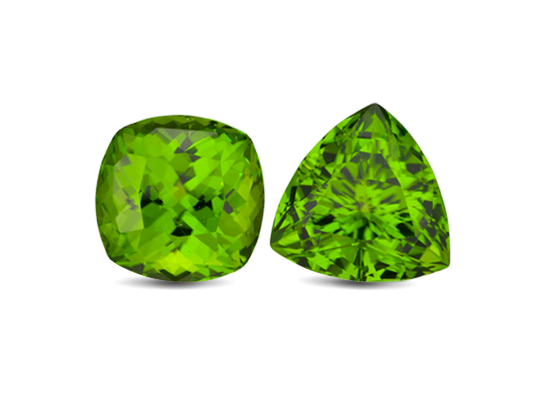
Photo credit to GIA
The US state of Arizona-sourced peridot is a particular favorite of jewelers. Because of its lemony yellow color and irregular shape, Arizona peridot is often made into jewelry suites that include a matching ring, pendant, earrings and bracelets.
Peridot’s signature green is enjoying a resurgence of popularity in fine jewelry. Capable of making a classic statement or being the centerpiece of fashion-forward pieces, peridot is fast becoming a modern staple of the gemstone world. Because peridot is plentiful and often large in size, fine peridot jewelry can be found in nearly every form imaginable. When fashioned into carved beads, suites, fantasy cuts, or cabochons, peridot’s versatility makes it a wonderful choice for any collection. Additionally, because peridot is cut into many various shapes and sizes, designers often build a piece around a spectacular peridot rather than placing it in a pre-manufactured setting.
Peridot is not a particularly hard gemstones. It is durable enough for jewelry wear, and best suited for earrings, pins, necklaces and pendants. Rapid and dramatic temperature changes can damage peridot. It can also be damaged by some acids and even by long-term exposure to acidic perspiration.
Peridot’s hardness and susceptibility to temperature change mean it requires special care. Peridot jewelry should be worn with care and protected from scratching and hard blows. It should be stored with care to avoid scratching by gems with greater hardness. Be sure peridot is never subjected to ultrasonic or steam cleaning, as these methods can easily damage the gemstone.
To clean peridot jewelry at home, we recommend a solution of warm water and gentle dish detergent and use of soft children's tooth brush. You can learn more about cleaning peridot and other gemstone jewelry in our blog Cleaning Fine Gemstone Jewelry. To learn about caring for your fine jewelry, please read our blog Caring For Fine Gemstone Jewelry.
Color Characteristics and Treatments
Peridot’s color range is narrow; from yellowish green to pure green to greenish yellow. Pure green stones are rare, with most peridots in yellowish green. Lower-quality peridot may have a brownish tint.
Most better-quality calibrated gemstones and larger single pieces on the market have no eye-visible inclusions. Minute mineral crystals, which appear as tiny black spots can be found under magnification. Other inclusions common in peridot are reflective, disk-shaped inclusions called “lily pads.” Value drops dramaticly for light-colored material with readily visible inclusions, especially dark spots.
The finest hue is an intense pure grass green without any hint of yellow or brown. Peridot’s finest colors tend to be found in stones weighing 10 or more carats. Most of the stones with the finest color come from Myanmar and Pakistan. Most fine peridot on the market is eye clean.
Peridot has extremely high double refraction. This means when you look closely through the gem, you can see two of each pavilion facet.
Even in its natural form, peridot’s distinct green hue is remarkably consistent —a feature rarely seen in gemstones. There are no known treatments of peridot such as heating or irradiaion. Occasionally, peridot is treated with colorless oils, waxes, or resins to fill voids or surface fractures and to improve the gem’s appearance or surface luster. Any enhancements to peridot should be disclosed to potential buyers.
Formation, Mining and Cutting
Peridot is the gem variety of the mineral olivine, an important group of silicate minerals found in the earth’s mantle. Olivine has a very high crystallization temperature, making it one of the first minerals in magma to crystallize. It’s typically olive green in color, transparent to translucent with a brittle texture and many fractures. Olivine is often found near the earth’s surface in and around tectonic plates in dark-colored igneous rocks. Iron causes peridot’s attractive yellowish green colors. The amount of iron in the crystal structures affects the intensity and tint of the green color.
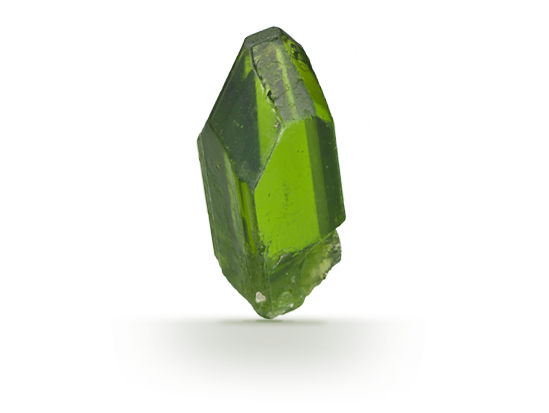
Photo credit GIA
Gem miners find peridot as irregular nodules (rounded rocks with peridot crystals inside) in some lava flows in the United States, China, and Vietnam. Very rarely, peridot is found as large crystals lining veins or pockets in certain types of solidified molten rock in Finland, Pakistan, Myanmar, and the island of Zabargad.
Geologists believe both types of deposits relate to the spreading of the sea floor that occurs when the earth’s crust splits, and rocks from its mantle are pushed up to the surface. Sometimes—as in Myanmar— these rocks can be altered, deformed, and incorporated into mountain ranges by later earth movements.
As described in the introduction, some peridot came to earth in meteorites, but extraterrestrial peridot is extremely rare, and not likely to be seen in a retail jewelry store.
Today, the primary sources of peridot are the United States, Myanmar, China and the Himalayan mountains of Pakistan. Additional sources include Australia, Mexico, Ethiopia, Tanzania, Vietnam, Norway, and Sri Lanka. The finest large peridots come from Myanmar, formerly Burma, and more recently, from the source high in the Himalayas of Pakistan, 15,000 feet above sea level. The finest quality Myanmar peridot has a deep color and superb transparency. China and the United States primarily supply standard size and commercial quality material. Massive volcanic eruptions many thousands of years ago sent rivers of lava spilling across the US state of Arizona’s desert landscape of what is today the San Carlos Apache Indian Reservation, where some Apache families have worked the mines for decades. Although Hawaii’s volcanoes have produced some peridot large enough to be cut into gemstones, virtually all peridot sold in Hawaii today is from Arizona.
Peridot from Zabargad has been prized for centuries and is still highly desirable, but little, if any, is still mined today.
Peridot is cut in a wide variety of shapes and cutting styles. Production includes all the standard gem shapes such as round, oval, pear, cushion, triangle, and marquise shapes. Cutting styles are also well represented. Brilliant cuts with triangular and kite-shaped facets, step cuts with concentric rows of parallel facets, and mixed cuts usually consisting of brilliant-cut crowns and step-cut pavilions are all common. Designer cuts fashioned by hand and machine are popular, as well as cabochons, beads, and carvings. Large crystals of peridot have created cut gems of more than 50 carats in size.
Famous peridot gemstones
- A 311.80-carat peridot from Zabargad Island, Egypt, is in the Smithsonian Institution’s collection.
- The Green Goddess, the Chicago Field Museum’s flawless 154-carat Zabargad peridot was purchased at the World’s Columbian Exposition in 1893, as seen below:
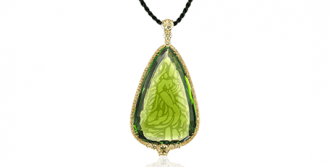
- A 127-carat peridot in the collection of The Field Museum of Natural History in Chicago is from Zabargad Island, Egypt.
- A 146.10-carat peridot is in the collection of the Natural History Museum in London.
- London’s Natural History Museum has peridot crystals found in 1951 in a meteorite which hit Argentina.
- A spectacular 346.45-carat crystal of peridot from Zabargad island, Egypt is in GIA’s gem collection. To see this lovely crystal, it can be found on YouTube.
Credit Gemological Institute of America and American Gem Trade Association

